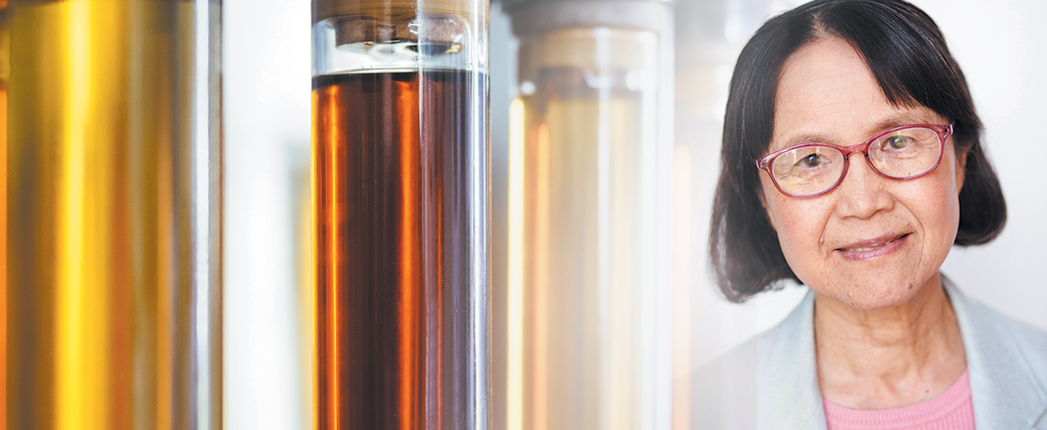
PAOs, Past and Present
Polyalphaolefins will be in the spotlight at the next National Inventors Hall of Fame induction ceremony. Margaret Wu, a chemist retired from ExxonMobil Research & Engineering, will be welcomed into the 48th class for her work to develop better polyalphaolefins for use in synthetic lubricants.
The ceremony has been rescheduled from May 2020 to October 14, 2021, in Washington, D.C., due to the COVID-19 pandemic.
In order to be eligible for induction into the organization, “nominees must hold a United States patent for an invention that has contributed to and advanced our society,” said Ken Torisky, public relations coordinator for the Canton, Ohio-based National Inventors Hall of Fame. All nominations are confidential.
Born in Taiwan, Wu earned her undergraduate degree in chemical engineering at the National Taipei University of Technology and her doctorate in physical organic chemistry at the University of Rochester in New York.
When she began working at Mobil in 1977, Wu was one of only a few female chemists at the company. She later became the first woman to be named senior scientific advisor at ExxonMobil and was the first woman from the company to be inducted into the National Academy of Engineering. Wu retired in 2009 but continued working as a consultant until 2016. She holds more than 100 U.S. patents.
One of the patents that earned Wu her place in the Hall of Fame was for a high viscosity index PAO with a low pour point. Compared to conventional PAOs of the time, as written in U.S. patent 4827064, the new base stock was “an oligomer substantially free of double-bond isomerization.”
In an interview with the National Inventors Hall of Fame, Wu explained, “The novelty of our product is that it has a very elegant chemical structure. It is put together in a very uniform and regular manner and has no extraneous undesirable side branches. If you look at the old products, they have small branches sticking out here and there. Because of the new chemical composition, the new molecules have significantly better lubricating properties.”
The fluids were made using a reduced valance state metal oxide catalyst such as chromium oxide. The lower branch ratio produced a higher viscosity index than commercially available PAOs of the time (about 160–220 vs. 130–160), while simultaneously delivering lower pour point—a surprising combination, Wu wrote in the patent application.
She pointed to the environmental and societal benefits of advances in lubrication as the motivation for her work. “I’m very conscientious about what we have done to our Earth. I wanted to be able to do something as a chemist to help make this place a little better,” she said. “In order to get the best performance or the best product, a chemist can go into the laboratory to build a perfect molecule, so it will do all the good things we want without the bad properties. That’s what a synthetic lube is about. It’s a huge improvement to our society’s wellbeing.”
Wu’s work is indicative of a bigger story surrounding PAOs—one of ongoing innovation. “Some of the first applications for PAO were in crankcase lubricants,” explained Ken Hope, global PAO technical services manager for Chevron Philips Chemical Co. However, it took until the 1970s for the fluids to gain a significant position in the lubricants market. More PAO-based products were developed later, including synthetic gear lubricants, greases and engine oils.
“The recognition of the excellent low-temperature properties observed in synthetic oils produced by Charles Friedel and James Mason Crafts in 1877, initially and subsequently tailored with the use of high-purity normal alpha olefins and catalyst refinements, today results in the synthetic products that have extremely low pour points, low viscometrics at low temperatures and very high viscosity indices,” said Hope. This high viscosity index and low-temperature fluidity allows PAO lubricants to be used over a wide temperature range.
“We now know that there are many other advantages [to PAOs] such as high thermal conductivity, high oxidative stability and low coefficient of friction,” he continued. “The advent of C12-based PAOs in 1995 by then Chevron Chemical Co. also is enabling the blending of low-volatility, low-viscosity engine oils.” These base stocks are made from molecules with 12 carbon atoms. Previously, PAOs had only been made from decene, or C10 feedstocks.
In the 2000s, PAOs were developed using metallocene catalysts that offer even higher viscosity index, lower pour points and better shear stability and oxidative stability.
It is no secret in the lubes industry that pressure will continue to be placed on lubricants and base stocks from more stringent requirements regarding energy conservation, environmental sustainability and technical performance. “These increased needs often call for solutions where the lubricants or greases need to be improved,” said Hope. “When this happens, formulators need to examine the tools that are available to work toward these improved products. It is the cutting-edge products that tend to employ the capabilities of PAOs.”
Lubricants continue to benefit from dedicated researchers working with PAOs. For example, ExxonMobil says it has formulated a blend of polyalphaolefins and alkylated naphthalene base stocks that can deliver the often-conflicting properties of low volatility and low viscosity needed for driveline lubricants in electric vehicles.
“We see new applications within the industry on a regular basis, and for this reason we remain encouraged for the future developments of PAO-based lubricants,” Hope affirmed.
Sydney Moore is assistant editor for Lubes’n’Greases magazine. Contact her at Sydney@LubesnGreases.com.